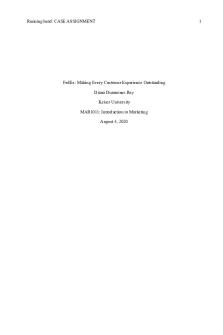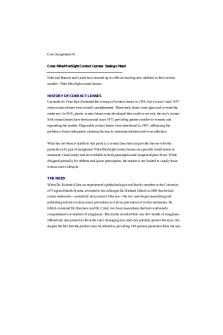Assignment 1 Zipcar Case PDF

| Title | Assignment 1 Zipcar Case |
|---|---|
| Author | Zhuoping Ying |
| Course | New Venture Capital |
| Institution | University of California San Diego |
| Pages | 2 |
| File Size | 58.9 KB |
| File Type | |
| Total Downloads | 90 |
| Total Views | 153 |
Summary
the first assignment group case in the class...
Description
Zhuoping Ying ID: A59012551 Meichen Chen ID: A59006116 Xiaoyang Cui ID:A16058446
Assignment 1 Zipcar Zipcar is a start-up company co-founded by Robin Chase and Antje Danielson that allows subscribers to use company-owned vehicles for a short term at the target location near the members. This car-sharing concept aims to bring efficiency to its members in terms of time and costs. Although the business of organized car sharing has a history of over a decade, mainly in Europe, the market demand and market scale remain rising. Chase also believed that an essential demand is ignored in the car sharing market that enables immediate short-term car access with ensured privacy. Chase conducted a sophisticated investigation including market demand, cost efficiency of existing world-wide car-sharing companies, and the main focus of her competitors in North America. She believed that there would be a strong demand for her product in the United States for people who prefer convenient short-term cars over taxis or daily rental cars. Therefore, Zipcar has its distinctive advantages to potentially win the market.Chase developed her business plan in many aspects by late 1999. She believed that there were at least 14 cities in the US that are suitable for Zipcar growing, and Boston is the best ideal location for launching the concept due to its traffic situation and proportion of high-educated individuals. In the next step, we analysed their business model and founding process in detail. As a start-up company, Zipcar faced financing problems and many preliminary preparations. Therefore, Chase had invested a lot of work as a full-time founder. Chase refined the concept, researched the market, wrote the business plan, and built the assumptions necessary to create a budget. She created the list of critical business and financing contacts. Since Chase realized the importance of the technology operation platform, she invested more funding in its implementation. She also negotiated and signed contracts for Zipcar parking. And she used low costs but efficient strategies to finish their market plan. A funding of $375000 was raised from several different investors. But the potential risks were gradually exposed, and she couldn't prove the Boston market’s viability. Chase faced many problems such as the customer base and number of cars are not enough, the operating and overhead costs still need to be handled and the management has met some problems before. In order to win market competition, their pricing strategy has always needed to be adjusted. Besides, Chase and her co-founder Danielson were also questioned by investors for lack of experience. The original business model in December 1999 was that Zipcar needed to cover their COGS and overhead by themselves, they also had a low application fee and a refundable application fee and mainly
generated the revenue from customers’ annual subscription fee. And in May 2000, the business model changed due to some potential customers thinking the annual fee is too high, free parking is not easy to find and lease costs are higher than they thought. So Chase made some changes to the pricing model: she increased the assumed attrition rate to 15% per year, the annual fees changed from $300 to $75, also raising the hourly charge from $1.5 to $5.5. Then, the revenues and variable costs increased due to the changes of business model. The data from actual operations in September showed the business model is not playing so well. The operating and overhead costs are higher than previously thought, which leads to greater risk and a higher return demand by investors. The good part from the data is that Zipcar keeps a large part of their members and the attrition rate is low. The concerning part is due to the high costs of operating and overhead. The total overhead costs never changed even after the price model changed. Because of these costs, businesses have a high risk of failure when consumer demand is low. After collecting the operating results and financial data of the company during the end of September, Chase found that several categories of company’s expenses were higher than the budget, including the car lease costs, parking fee, fuel expenditure, as well as the overhead. Although the remaining expenses are close to the budget such as the marketing cost, it is essential to reduce the cost or increase the revenue to solve the pricing issue. For example, Zipcar could increase the per mile fee or per hour fee when the driver reaches a certain mile or time. Besides, Zipcar cloud also put more effort on developing the technology to avoid the overhead fee and reduce the cost. Last but not least, designing a dynamic leasing strategy with car companies may reduce the expense and increase the utilization of current leased cars. At the Springboard 2000 New England venture forum, Chase should emphasize the company’s current progress and its profit potential to attract more investors. The strongest argument that Chase made to a potential investor about the attractiveness of the venture is her current success in Boston where the estimated Zipcar users will achieve 10,000 in five years. With the similar business strategy and business model, there will be at least 14 cities in the US that could replicate the success of Boston. These analysis and data proved that the Zipcar brand has undoubtedly redefined a new business model, and they succeeded in occupying a place in the car-sharing market that has begun to take shape. The technology trading platform created by Zipcar and its low-cost marketing model are also very creative and leading....
Similar Free PDFs

Assignment 1 Zipcar Case
- 2 Pages

Zipcar as-is
- 1 Pages

Week 1 Case Assignment
- 4 Pages

Assignment 1 case study
- 10 Pages

Assignment 1 CASE Study
- 9 Pages

Case Study Assignment 1
- 21 Pages

Assignment Case 1
- 4 Pages

Assignment Case Study-1
- 6 Pages

Case 1 - Airbnb and Assignment
- 4 Pages

Avion case study 1 - Assignment
- 4 Pages

CASE Study 1- Facebook - Assignment
- 19 Pages

Assignment 1 Case Study (Hausboom)
- 14 Pages

Legal Case Briefing Assignment 1
- 4 Pages

BUSI 472 Case Assignment 1
- 8 Pages
Popular Institutions
- Tinajero National High School - Annex
- Politeknik Caltex Riau
- Yokohama City University
- SGT University
- University of Al-Qadisiyah
- Divine Word College of Vigan
- Techniek College Rotterdam
- Universidade de Santiago
- Universiti Teknologi MARA Cawangan Johor Kampus Pasir Gudang
- Poltekkes Kemenkes Yogyakarta
- Baguio City National High School
- Colegio san marcos
- preparatoria uno
- Centro de Bachillerato Tecnológico Industrial y de Servicios No. 107
- Dalian Maritime University
- Quang Trung Secondary School
- Colegio Tecnológico en Informática
- Corporación Regional de Educación Superior
- Grupo CEDVA
- Dar Al Uloom University
- Centro de Estudios Preuniversitarios de la Universidad Nacional de Ingeniería
- 上智大学
- Aakash International School, Nuna Majara
- San Felipe Neri Catholic School
- Kang Chiao International School - New Taipei City
- Misamis Occidental National High School
- Institución Educativa Escuela Normal Juan Ladrilleros
- Kolehiyo ng Pantukan
- Batanes State College
- Instituto Continental
- Sekolah Menengah Kejuruan Kesehatan Kaltara (Tarakan)
- Colegio de La Inmaculada Concepcion - Cebu

